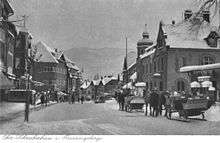Szklarska Poręba
| Szklarska Poręba | |||
|---|---|---|---|
|
Town centre | |||
| |||
 Szklarska Poręba | |||
| Coordinates: 50°50′N 15°32′E / 50.833°N 15.533°E | |||
| Country |
| ||
| Voivodeship | Lower Silesian | ||
| County | Jelenia Góra | ||
| Gmina | Szklarska Poręba (urban gmina) | ||
| Area | |||
| • Total | 75.44 km2 (29.13 sq mi) | ||
| Highest elevation | 886 m (2,907 ft) | ||
| Lowest elevation | 440 m (1,440 ft) | ||
| Population (2006) | |||
| • Total | 7,094 | ||
| • Density | 94/km2 (240/sq mi) | ||
| Website | Szklarskaporeba.pl | ||
Szklarska Poręba [ˈʂklarska pɔˈrɛmba] (German: Schreiberhau) is a town in Jelenia Góra County, Lower Silesian Voivodeship, in south-western Poland. The town has a population of around 7,000. It is a popular ski resort.
An important regional and national centre for mountain hiking, cycling and skiing, Szklarska Poręba is situated in the valley of the Kamienna, between the Karkonosze Mountains in the south and Jizera Mountains in the west, at 440–886 m above sea level, 16 miles (26 kilometres) south-west of Jelenia Góra. The ski resorts in this area are growing in popularity as a budget alternative to the Alps, thanks to wide range of both Alpine and Nordic skiing facilities.
History
The village was established in the Lower Silesian Duchy of Jawor by German colonists on a spot bought by Knights Hospitallers descending from Calidus Fons (Bad Warmbrunn, now Cieplice Śląskie-Zdrój in Jelenia Góra), who were interested in finding gold and precious gems in the area.[1] It was first mentioned in 1366 and 1372 in conjunction with a glass factory, forerunner of the famed later Josephinenhütte, as Schribirshau and Schreibershow.
In 1578 several Bohemian Protestants moved to the village and greatly contributed to its development.[2] Among the refugees was Marie Pluch, which gave the district Mariental its name. Over time the glass factory moved deeper into the mountains. In 1617 the Preußler family migrated from the southern Bohemian side of the Karkonosze ridge to Silesia and received a concession to run a movable glass factory from the counts of Schaffgotsch, landlords of Schreiberhau. The glass industry of the village was dominated by the Preußler family for the next 200 years. In 1842 Franz Pohl, son-in-law of the last Preußler, persuaded Count Schaffgotsch to establish a new glass factory in Schreiberhau. This Josephinenhütte became the largest and best glass factory in Silesia, while Schreiberhau greatly expanded to become the largest village in Prussia,[3] with 15 districts covering 43 square kilometres (17 sq mi).

Around 1900 several artists discovered the beauty of the countryside and formed the Schreiberhau artists' colony, among them Gerhart Hauptmann and his brother Carl, Otto Mueller and Wilhelm Bölsche. Later, younger artists formed the St. Lukas artists' association. In 1925 the first winter games of the International Workers Olympiad (organised by the Lucerne Sport International) were held in the town. Twelve national delegations participated.[4]
After World War II Schreiberhau became part of Poland (see Territorial changes of Poland after World War II) and was renamed Szklarska Poręba (literally "glass clearing"). The German inhabitants were forcibly expelled and the village resettled with Poles. The Josephinenhütte was moved to Schwäbisch Gmünd. The glass factory in Szklarska Poręba was renamed and continued to operate. On 22–27 September 1947 the conference on the establishment of the communist information office (Kominform) took place in the village. The village gained the status of a town in 1959.
Transport
The town used to be connected via the Zackenbahn railway to Tanvald in Bohemia. The cross-border passenger line was closed in 1945 when the town was given to Poland and remained closed until 2010. In 2010 the cross-border railway connection was reconstructed and is now operated by passenger trains from Kořenov. The railway connection to Jelenia Góra plays a minor role, since the scale of the mining industry in the town's vicinity has decreased.
A section of national road no. 3, also part of European route E65, passes through the town.
International relations
Twin towns — Sister cities
Szklarska Poręba is twinned with:
 Augustów, Poland
Augustów, Poland Aulum-Haderup, Herning, Denmark
Aulum-Haderup, Herning, Denmark Bad Harzburg, Germany
Bad Harzburg, Germany Harrachov, Czech Republic
Harrachov, Czech Republic Kořenov, Czech Republic
Kořenov, Czech Republic
Footnotes
- ↑ Historiai Miasta official website of Szklarska Poręba
- ↑ Historiai Miasta official website of the Szklarska Poręba
- ↑ Schüttig, p.88
- ↑ Wheeler, Robert F.. Organized Sport and Organized Labour: The Workers' Sports Movement, in Journal of Contemporary History, Vol. 13, No. 2, Special Issue: Workers' Culture (Apr., 1978), pp. 191-210
References
- Weczerka, Hugo (2003). Handbuch der historischen Stätten: Schlesien. Stuttgart: Alfred Kröner Verlag. ISBN 3-520-31602-1.
- Schüttig, Frank (2005). Das Riesengebirge entdecken. Potsdam: Trescher Verlag. p. 263. ISBN 3-89794-073-6.
External links
![]() Media related to Szklarska Poręba at Wikimedia Commons
Media related to Szklarska Poręba at Wikimedia Commons
- Skiing in Szklarska Poręba
- Municipal website
- www.szklarska-poreba.pl Szklarska Poręba - gallery, news, map
Coordinates: 50°50′N 15°32′E / 50.833°N 15.533°E


